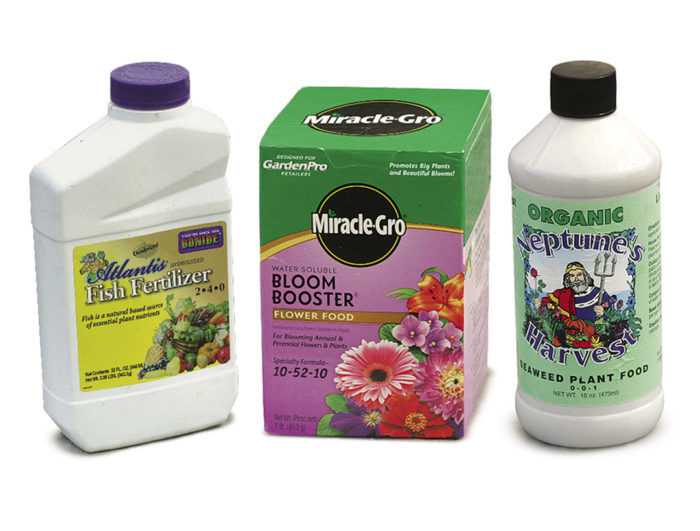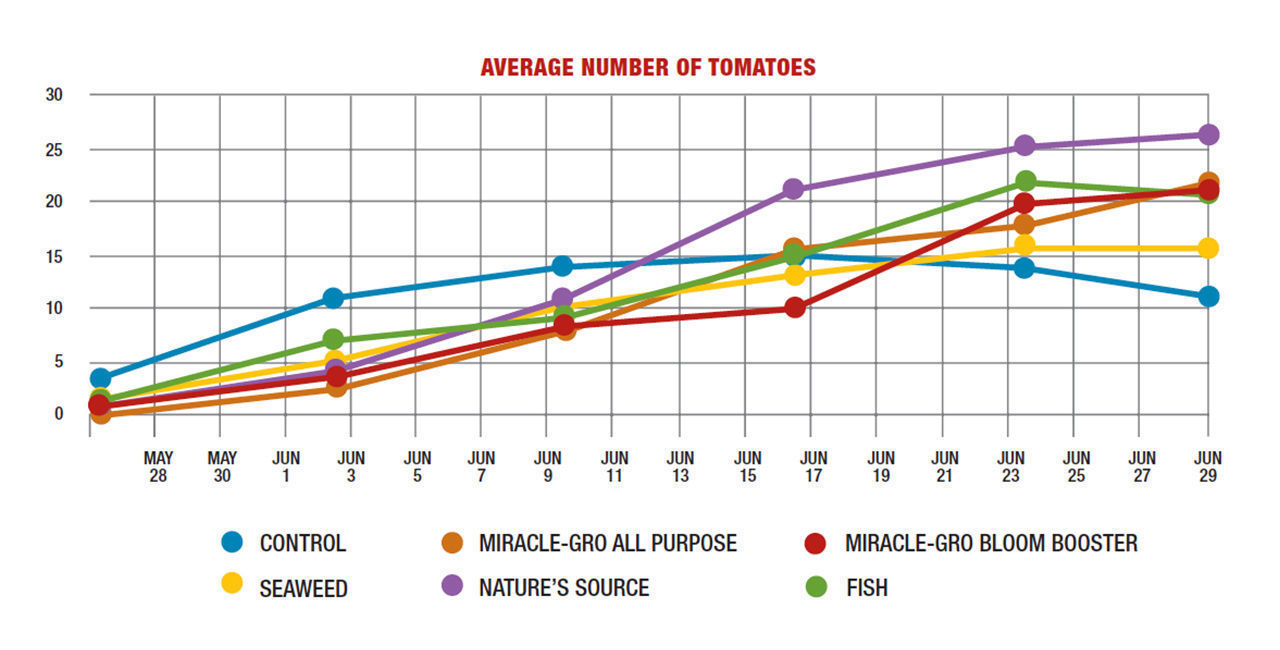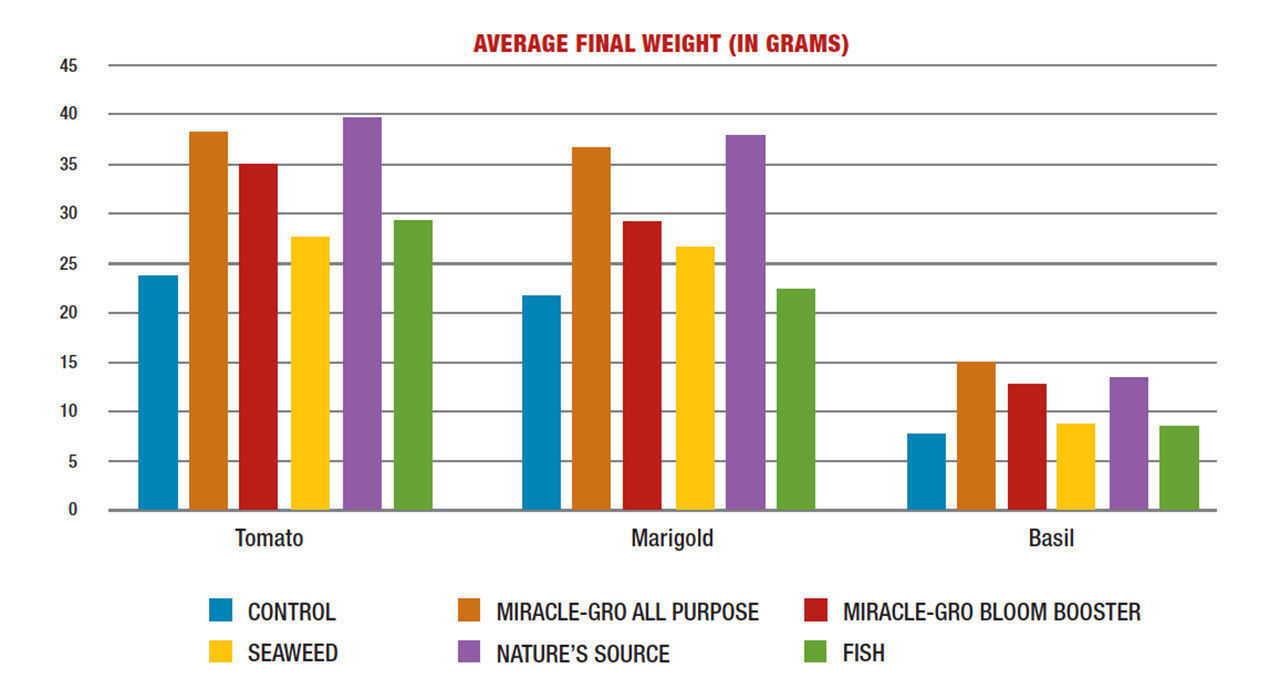Water-Soluble Fertilizers
Find out which ones are best for your plants and for your wallet

If you have ever shopped for fertilizer for your plants, then you know the wide variety of options available. Water-soluble fertilizers are popular, often because they seem easy to work with: a scoop or so in the watering can and you’re done. Even within this subcategory, the options seem daunting: Organic? Synthetic? High phosphorus to promote blooms?
To help clear these muddy waters, we tested five water-soluble fertilizers derived from a variety of sources. We applied them to plants grown for their fruit (‘Sun Gold’ tomato), flowers (a dwarf marigold mix), and foliage (‘Purple Ruffles’ basil). And while some of the results might be what you would expect, there were a few surprises.
How we conducted the tests
Our control group of plants was grown with no fertilizer besides what was in the potting mix (Fafard 3B—a professional growing medium similar to many over-the-counter mixes) to see whether adding fertilizers made a difference in growth. The plants were planted in April, and we applied fertilizers every two weeks at the rates recommended for container plants on the packaging. In two cases, we did not follow the packaging instructions exactly as written. First, we applied Miracle-Gro Liquid All Purpose fertilizer at half of the recommended rate (this was an error caused by misreading the label and not the fault of the company); second, we used fish fertilizer every two weeks instead of every month as recommended on the packaging (this was done for the sake of consistent application across fertilizer types). All of these fertilizers were applied to three of each of the plant types tested. Average flower number and fruit number per plant were tracked for marigolds and tomatoes, respectively. At the end of the experiment, all plants were dried and weighed.
What we tested
We tested a range of fertilizers that come from different sources: organic options, like seaweed and fish emulsion, to synthetics like Miracle-Gro. The NPK ratio is the percentage of the nitrogen, phosphorus, and potassium, respectively, that the fertilizers provide. All of these fertilizers are widely available, and the costs presented are from amazon.com.
 |
Bonide Atlantis Fish Fertilizer
NPK: 2–4–0 Cost: $11.67 for 1 qt. |
 |
Miracle-Gro Bloom Booster
NPK: 10–52–10 Cost: $9.04 for 1 lb. |
 |
Nature’s Source Plant Food
NPK: 10–4–3 Cost: $16.99 for 1 qt. |
 |
Miracle-Gro Liquid All Purpose Plant Food
NPK: 12–4–8 Cost: $5.92 for 1 qt. |
|
|
Neptune’s Harvest Organic Seaweed Plant Food
NPK: 0–0–1 Cost: $15.20 for 1 qt. |
Feeding works but not always how you would expect
All fertilizers offer a range of nutrients to plants, including nitrogen, phosphorus, potassium, calcium, zinc, and a host of other elements. Of these, nitrogen usually has the most effect on plant growth. Adding nitrogen usually results in more growth. This was evident in our study. The final average weights of the plants tested provided an obvious way to separate the influence of fertilizers on plants. As expected, plants grown without fertilizer were smaller than plants grown with fertilizer. Of the plants treated with fertilizer, those that offered the lowest percentage of nitrogen resulted in the smallest plants, while those with higher levels of nitrogen resulted in larger plants.
All of the plants grew reasonably well with no obvious nutrient deficiencies; however, some differences in plant growth emerged as the experiment continued.

One of the most interesting things that we saw was the earlier emergence and greater number of fruit on tomato plants that were not fertilized. Though interesting, this is not surprising because, unlike the fertilized plants, the plants given no fertilizer immediately devoted their energy to reproduction (fruit production) instead of vegetative growth (stem and leaf growth). Plants that were fertilized devoted their energy to growth and developed fruit later than the control plants. By the end of the experiment, they were clearly producing more fruit. The same general trend was seen with marigold flowers. With sufficient nutrients, plants prefer to grow before they reproduce, but if nutrients are limited, plants prefer to devote what resources they have to ensuring that there is another generation.

One of the most interesting things that we saw in this experiment was the failure of Miracle-Gro Bloom Booster to provide a consistent increase in average bloom number in marigolds or fruit number in tomatoes (which should be expected because blooms turn into fruit). At only one sampling date for marigolds did Bloom Booster have the highest average number of blooms. Bloom Booster is supposed to work by offering plants a high dose of phosphorus, an element that is supposed to improve the number of blooms. Phosphorus is certainly required for plants to bloom; however, only a small amount is needed. Adding more phosphorus can even be considered a waste of a natural resource because most phosphorus for fertilizers is mined from a limited number of sites around the world. With an analysis of 10–52–10, Bloom Booster offers a level of phosphorus that is excessive for most plants. Remember that any phosphorus added to your plant beyond what the plant uses could end up running down a gutter and into a local pond or lake. Once it’s there, it will undoubtedly feed algae and contribute to a damaging reduction of oxygen in the water, which could suffocate fish and other aquatic creatures. Though the use of a half rate of Miracle-Gro All Purpose fertilizer was an accident, it did show that, even when applied at less than the recommended concentration, fertilizers can still have a significant effect on growth. Though a little more fertilizer can improve plant growth, plants can still grow and be perfectly healthy with much less fertilizer than what is recommended.

Using fertilizer provides better results than not using fertilizer, and paying attention to the amount of nitrogen and phosphorus in the fertilizer you are using is important. What appears to be less important is whether the product is organic or synthetic as both types performed well in our tests. Based on our results, our recommendation would be to select a fertilizer with a low concentration of phosphorus relative to the amount of nitrogen, something like a 5:2 ratio, and to apply it according to label instructions—or even at a lower concentration.
How do water-soluble fertilizers work?
What is the benefit of these fertilizers?
Unlike granular, slow-release fertilizers, water-soluble fertilizers offer nutrients already dissolved in water, so they will be quickly available to plants.
Are organic options different than synthetic ones?
There are so many different types of organic and synthetic fertilizers that dividing them along these lines isn’t a reasonable thing to do. That said, organic fertilizers are often (but not always) made from renewable resources, might be more likely to release nutrients slowly, and might be more likely to contain valuable micronutrients.
Is salt buildup in the soil an issue?
This can be an issue with any fertilizer. For most fertilizers, it’s important not to add them with every watering so that you can flush out any excess fertilizer. Be sure to follow the instructions on the label.
Is it worthwhile to use them on in-ground plants?
Water-soluble fertilizers will work fine for in-ground plants; however, some of the fertilizer is likely to run off during application. Granular fertilizers will release more slowly with soil moisture and are likely to be more efficient, unless you have a downpour right after they’re applied.
Jeff Gillman teaches horticulture at Central Piedmont Community College in Charlotte, North Carolina, where Mae Lin Plummer is a student.
Photos: Steve Aitken






Comments
Log in or create an account to post a comment.
Sign up Log in